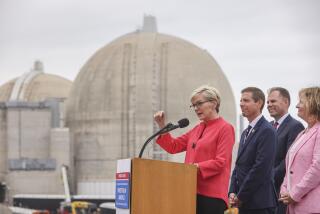Civilian Reactors May Make Weapons Gas : Nuclear: U.S. weighs using non-military facilities to produce tritium for bombs.
- Share via
WASHINGTON — In a move that critics fear could blur the lines between civilian and military nuclear operations, the Clinton Administration said Tuesday it would consider the use of a civilian reactor to produce a radioactive gas crucial to building nuclear weapons.
The Administration also said it might build a linear accelerator to make the gas instead of using a reactor.
By holding out the possibility of using civilian reactors to produce the warhead gas, the Administration risks crossing the same line that it has accused North Korea and Iraq of crossing--the line separating civilian nuclear power reactors from equipment producing nuclear weaponry, critics contend.
The Department of Energy has been under intense pressure from the Pentagon to decide how it would produce tritium, a gas the government estimates will be in short supply by the year 2011 unless new sources are developed.
In announcing that the government would pursue two sources of tritium, Energy Secretary Hazel O’Leary said that “the bottom line is to assure tritium production for our nuclear weapons stockpile rapidly, cost-effectively and safely. The dual-track approach will best assure we meet that critical objective.”
But Daryl Kimball, associate director for policy at the Physicians for Social Responsibility, said that the choice begs a crucial question: If the United States and Russia continue to reduce their nuclear arsenals over the next decade, won’t the need for tritium shrink significantly?
In addition, he said, “If other nations even perceive the United States as using its latent civilian commercial nuclear power industry for military purposes, that would send a bad signal to those nations around the world that are rightfully and legally pursuing nuclear power under international treaties.
“We would not want to commit that . . . error. It would make stopping nuclear proliferation that much more difficult,” Kimball added.
However, Paul Leventhal, president of the private Nuclear Control Institute, praised the decision because it would not lead to construction of a new reactor.
Tritium serves as an explosive booster in a nuclear weapon. It is placed in a hollow sphere of plutonium, and the two are surrounded by high energy conventional explosives. The compression of the sphere produces a critical mass, triggering a thermonuclear explosion with the power of millions of tons of TNT.
The decision on tritium production involves such disparate issues as whether the United States needs the gas and how much is required; the cost of building a linear accelerator versus the cost of production using a light-water reactor, and the jobs that could be lost if the leading candidate among reactors, a facility at Savannah, S.C., is not employed in the production.
The Savannah site was operated by a civilian agency and used for tritium production until it was shut for safety reasons in 1988. The issue of using civilian reactors in the production of military weapons has become critical only in recent years, as the Cold War subsided and nuclear proliferation among Third World countries became a greater concern.
The choice of the Savannah site could save 2,900 jobs there, and O’Leary has been under pressure from such influential Republican members of the South Carolina congressional delegation as Sen. Strom Thurmond and Rep. Floyd Spence, chairman of the House National Security Committee, to give it primary consideration.
Whichever course is chosen, South Carolina would benefit. O’Leary said that if an accelerator is built, it would be constructed at a weapons complex near Aiken, S.C.
Offering benefits from either path, the Energy Department said that an accelerator produces no high-level radioactive waste, while an existing commercial reactor, which produces such waste, would be cheaper, at least in the short run.
“We’re hedging our bets,” O’Leary said.
Overall, the department is seeking $323 million over the next three years for its tritium program.
Tritium decays at a rate of 5.5% a year. None has been produced since 1988, and with nuclear weapons being destroyed at a rate of roughly 2,000 a year under the U.S.-Russian arms reduction treaty signed in 1989, some of the existing tritium is being removed from older weapons for insertion in newer warheads.
To begin production that will meet the deadline of resupplying weapons by the year 2011, an Energy Department official estimated, a decision on production must be made within the next three years. This would leave sufficient time to gain environmental permits and construct a linear accelerator if that course is chosen.
“This says we will look at both for three years and then decide what will be the primary source,” said Energy Department spokesman Rick Oborn.
More to Read
Sign up for Essential California
The most important California stories and recommendations in your inbox every morning.
You may occasionally receive promotional content from the Los Angeles Times.










